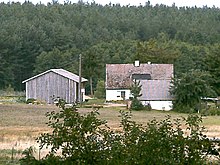Łękwica
Łękwica , also Lękwica (German Lankwitz , Kashubian Łenkwicô ) is a village near the city of Słupsk (Stolp) in the Pomeranian Voivodeship in Poland .
Geographical location
The village is located in Western Pomerania , about 15 kilometers northeast of Słupsk and six kilometers south of the Jezioro Gardno (Lake Garda) .
history
The village emerged as a scattered settlement. In a fiefdom from 1493, the village, which was formerly an old fief of the Bandemer family , appears under the place name Lanckewitze . Around 1784 there was a Vorwerk, a full farmer , a half farmer , two cottages and a total of six households in Lankwitz . Around this time the village was owned by Colonel Ernst Ludwig von Bandemer, who had bought it from a family member for 3,000 thalers . The village remained in the possession of the Bandemer family until 1825. In 1858 the estate was bought by a Mr. Hell. After that, the owners changed a few times.
In 1925 there were 33 residential buildings in Lankwitz with a resident population of 173 inhabitants (thus an average of 5.24 inhabitants per house). The majority of the population, with 171 Protestants (98.8%), were Protestant , while only two inhabitants (1.2%) were Roman Catholic . In 1939 there were 167 inhabitants living in 34 households. In addition to the property, which was 178 hectares in size, there were twenty farms in Lankwitz. In 1938, Artur Schwertfeger was the owner of the estate.
Before 1945 Lankwitz belonged to the district of Stolp , administrative district Köslin , the province of Pomerania . The parish area was 510 hectares. Lankwitz was the only place of residence in the Lankwitz community.
Lankwitz was occupied by the Red Army on March 9, 1945 towards the end of World War II . Since the village was in the Russian military restricted area on the Baltic Sea, the villagers had to leave their village temporarily on March 29, 1945. The villagers came to a collection camp in Starnitz in the Stolp district, where around 1000 people were housed. Many died here of typhus . At the beginning of May the Lankwitz family were allowed to return home. In autumn 1945 the Poles came. The residents were expropriated and driven out . Lankwitz was renamed Łękwica .
Later, 86 villagers from Lankwitz were identified in the Federal Republic of Germany and 41 in the GDR .
Today the village has about 60 inhabitants.
church
The population present in Lankwitz before 1945 was predominantly Protestant . Lankwitz was affiliated with the parish Groß Garde and thus belonged to the parish of Stolp-Altstadt.
school
Before 1945 Lankwitz had a primary school. This was single-stage in 1932; at that time a single teacher was teaching 47 school children.
literature
- Karl-Heinz Pagel : The district of Stolp in Pomerania . Lübeck 1989, pp. 690–692. ( PDF; 550 kB Description of Lankwitz )
Web links
Individual evidence
- ↑ Ludwig Wilhelm Brüggemann : Detailed description of the current state of the Royal Prussian Duchy of Western and Western Pomerania . Part II, Volume 2, Stettin 1784, p. 978, No. 77
- ^ A b Karl-Heinz Pagel : The district of Stolp in Pomerania . Lübeck 1989, p. 692 ( PDF description of Lankwitz )
Coordinates: 54 ° 35 ' N , 17 ° 9' E
